1
In 1810 the fur trading company, the North West Company, was pushing through British Columbia in search of fur and trade routes with the natives. David Stuart and Ovid de Montigny were the first white traders to have recorded travelling into the Okanagan Valley, making it to the headwaters of the Okanagan Lake. The Okanagan would not see another white man for 48 more years.2
View of the Okanagan Mission ValleyCirca 1892
Okanagan Mission Valley, Kelowna, British Columbia
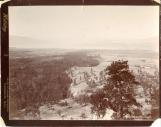 Credits:
Credits:Kelowna Public Archives
3
In 1813, the Okanagan and as far north as Fort Kamploops were a part of the Territory of Columbia. Two traders, William Pion (a Sandwich Islander) and Chief N'Kwala had made their headquarters on the tip of the peninsula at the head of Okanagan Lake in 1814. In 1821 the North West Company and the Hudson Bay Company consolidated, leading to a trail being blazed on the west banks of Okanagan Lake in 1824 to establish new trade routes between the Fraser and Columbia Rivers. With the Boundary settlement in 1846, the course of travel into the interior of British Columbia was changed, with trade now being routed from the Fraser Valley to Fort Langley, which was the first capital of the Crown Colony, British Columbia. The Okanagan Trail was not used again until the gold stampedes of the 1850s, starting with the discovery of gold in Kamloops in 1852. The gold rush signaled the end of the fur trade, and by 1858 there were as many as 30,000 miners in British Columbia.4
View of the Okanagan Mission Valley from Dilworth MountainCirca 1892
Okanagan Mission Valley, Kelowna, British Columbia
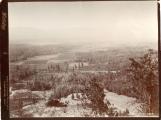 Credits:
Credits:Kelowna Public Archives
5
The Palmer and Miller Expedition was the first wagon train through the Okanagan Valley in 1858, and brought the first white people into the Valley since David Stuart and Ovid de Montigny. The expedition started in Walla Walla in the Oregon Territory, and was heading for the gold fields in the Cariboo. When they reached Okanagan Lake at Summerland, they unassembled their seven wagons (each loaded with 3,000lbs of tools, clothes and food) and ferried their loads across the Lake to L'Anse au Sable (The Cove of Sand - Mission Creek), where they reassembled their wagons and continued north to Fort Kamloops. At Fort Kamloops they sold their wagons, oxen and goods. In 1861 the Dewdney Trail was established on Canadian Land, bringing miners through Rock Creek and into the Okanagan.6
Cloverdale Ranch owned by George Whelan1863-1893
Ellison, Okanagan Valley, British Columbia
 Credits:
Credits:Kelowna Public Archives
7
In 1857 Father Pandosy, an Oblate priest, had established a mission at Yakima in Washington State, but after being accused by the local authorities of siding with the natives following a murderous skirmish and finding guns and powder buried in the Mission, Father Pandosy was told to leave the country. At first he sought asylum with the Jesuits at Colville and then with the Jesuit Fathers at Coeur d'Alene, but in the spring of 1859, upon advice from Bishop Demers of Vancouver, Father Pandosy returned to Colville for supplies and to enlist the aid of any families who might wish to accompany Pandosy and Father Richard to the new mission site in the Okanagan. Cyprian Laurence, his native wife, Teressa, and brother Theodor, accompanied the Oblate Priests, with William Pion acting as the escort and scout of this small party, packing them into the Okanagan in 1859.8
View of the Dilworth BluffsBefore 1902
Dilworth Mountain, Kelowna, Okanagan Valley, British Columbia
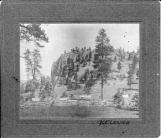 Credits:
Credits:Kelowna Public Archives
9
Father Pandosy wrote to Reverend Father D'Herbomez on October 9, 1859:We arrived tonight at a place which we have chosen for our Mission. It is a great valley situated on the left bank of the great Lake Okanagan, and rather near the middle of the Lake. . . . . .
10
View of Kelowna and Okanagan LakeCirca 1912
Okanagan Lake, Kelowna, Okanagan Valley, British Columbia
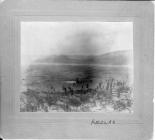 Credits:
Credits:Kelowna Public Archives
11
L'Anse au Sable is the largest valley of all the surrounding country, all who know it, praise it. The cultivable land is immense, and I myself believe that if Br. Blanchett is able next year to plant some vine cuttings, we shall be able to start a plantation."The Missionaries and their party of settlers made their first camp at Duck Lake next to the Parson Brothers, and suffered through the first winter which proved to be intensely cold with deep snow forcing them to kill their horses for survival and to live on moss, dried berries and roots. In the spring of 1860 they moved further down the Valley, and settled on Mission Creek where there was better cultivable land to establish a permanent mission. Between 1861 and 1863, more settlers came into the Valley, amongst them John McDougall, a Hudson's Bay Company trader, and his native wife, Eli Lequime and his wife Marie Louise and sons, Bernard and Gaston, August Calmels and his wife and partner Chapuis, Joseph Christien, Isadore Boucherie, August Gillard, Jules Blondeaux, and Francois Ortholan.
12
Hockey game on Bankhead PondCirca 1900
Dilworth Mountain, Kelowna, Okanagan Valley, British Columbia
 Credits:
Credits:Kelowna Public Archives
13
The first several years were a struggle for the priests and settlers, with W.G. Cox in 1862 referring to the owners of the five cultivated farms as paupers, without enough money between them to construct a flour mill even though the wheat crops were looking promising. However, by 1863 the settlers and the Mission were beginning to benefit from their hard toil.In 1863 Provincial Constable W.C. Young wrote to John C. Haynes Esq. at Sooyoos Lake:
. . . [Arrived] at the Mission settlement on the 28th [November] . . . weather warm and pleasant and the country free from snow. The cabins, farms, fences and haystacks in every direction gave the country a pleasant appearance after travelling the dreary mountain trails.
14
A.B. Knox Ranch. House, barn and young fruit trees.Circa 1891
Okanagan Mission Valley, Kelowna, British Columbia
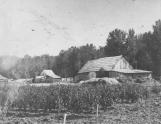 Credits:
Credits:Kelowna Public Archives